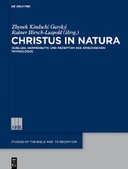Explore

Christus in natura
0 Ungluers have
Faved this Work
Login to Fave
This volume offers detailed studies into the Physiologus, a Greek manuscript probably written in Egypt in the 2nd century CE. The Physiologus was the first Christian text to sum up a general understanding of nature using biblical and pagan sources and it has an extensive reception history throughout the medieval period. Its symbolic use of animals and plants, etc., has deeply influenced visual arts, literature, and heraldry, but this visual language often remains enigmatic. This book, going back to a project of the Swiss National Foundation (Das ‹Evangelium der Natur›. Der griechische Physiologus und die Wurzeln der frühchristlichen Naturdeutung) offers new insights into the origins and the interpretation of this symbolic language.
This book is included in DOAB.
Why read this book? Have your say.
You must be logged in to comment.
Rights Information
Are you the author or publisher of this work? If so, you can claim it as yours by registering as an Unglue.it rights holder.Downloads
This work has been downloaded 143 times via unglue.it ebook links.
- 58 - pdf (CC BY-NC-ND) at OAPEN Library.
- 80 - pdf (CC BY-NC-ND) at Unglue.it.
Keywords
- Ancient religions & mythologies
- Christian Churches & denominations
- christianity
- Church history
- facsimile
- Humanities
- Natural history
- Other non-Christian religions
- Physiologus
- Physiologus natural history symbolism facsimile
- Religion & beliefs
- Symbolism
- The Early Church
- thema EDItEUR::Q Philosophy and Religion::QR Religion and beliefs::QRA Religion: general::QRAX History of religion
- thema EDItEUR::Q Philosophy and Religion::QR Religion and beliefs::QRM Christianity
Links
DOI: 10.1515/9783110494143Editions


